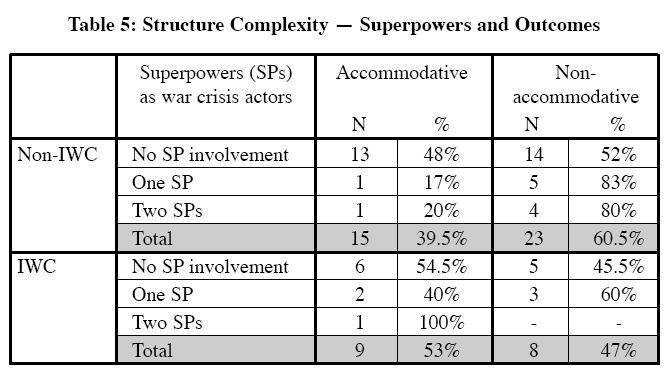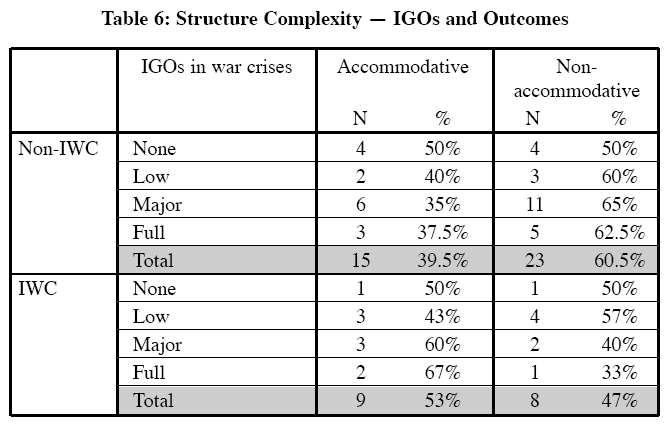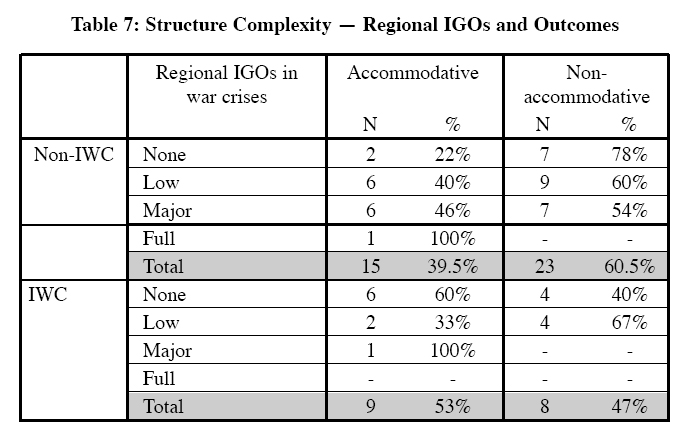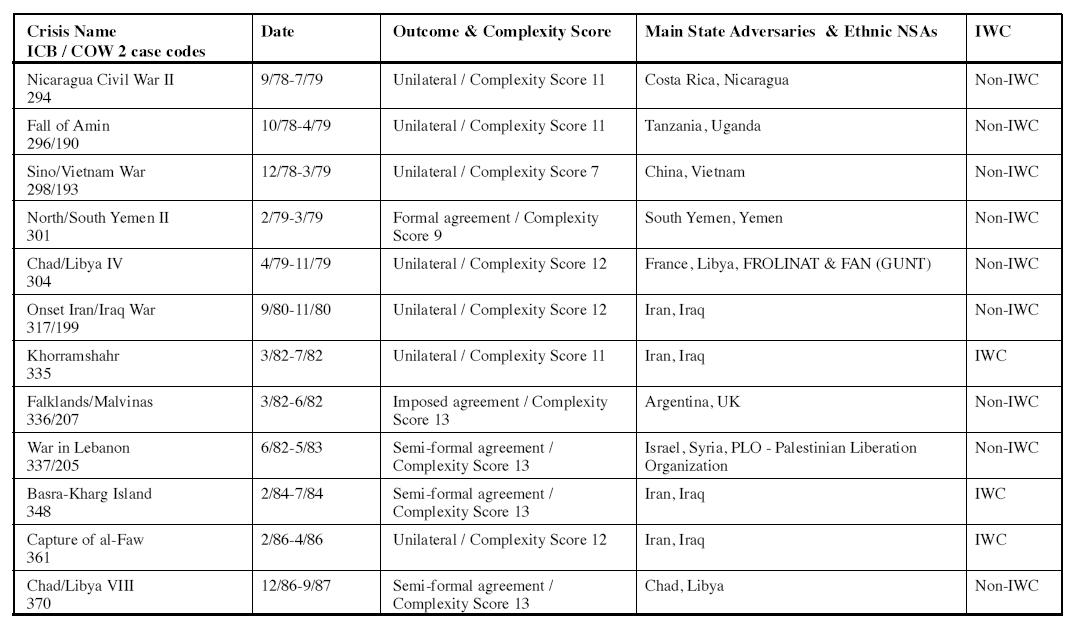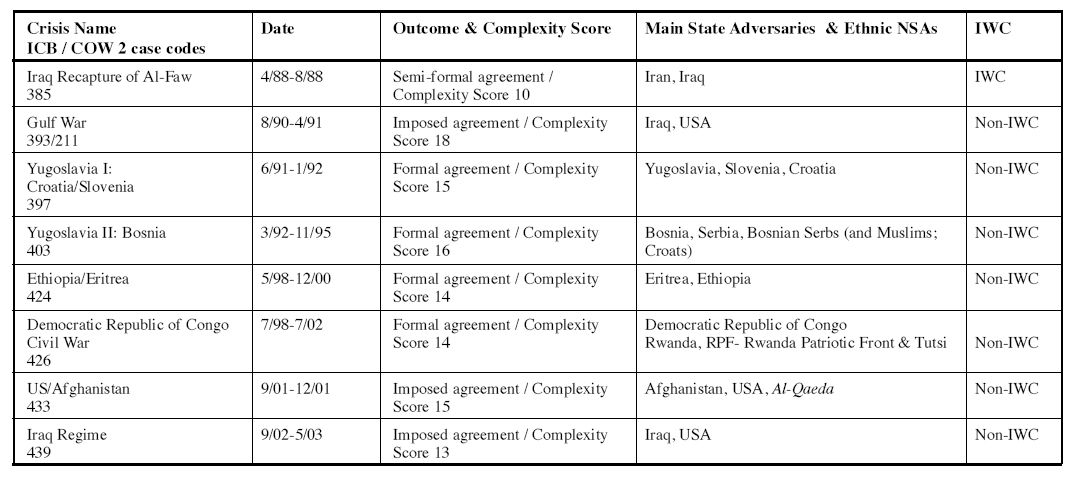Articles
War Complexity and Outcomes, 1946-2002
Hemda Ben-YehudaSenior Lecturer in the Department of Political Science at Bar Ilan University
Abstract
This study on war crises offers an operational index of complexity and spells out four postulates relating issue and structure elements to war outcomes. We expect that wars over territorial issues will end in an accommodative manner (postulate 1); that ethnic wars, though rare, will end in a non-accommodative outcome (postulate 2); and that clash of civilization issues, more than all other issues, will end in a non-accommodative way (postulate 3). Finally, wars with overall low complexity will end in accommodation while high complexity wars will not (postulate 4). Using ICB data, this study of 55 war crises, from 1946 to 2002, compares two situations: Intra-War Crisis (IWC), namely, long ongoing wars that are waged before the crisis begins (17 cases) and regular wars that occur after the crisis starts (38 cases). Findings from the study indicate that not all wars are alike. The substance of issues involved in the confrontation matters and complexity affects accommodation. Overall complexity is coupled, in part, with outcomes and, as anticipated, patterns of regular wars and IWCs vary. These findings on war diversity highlight the need for a comprehensive ‘multi path’ model to war.INTRODUCTION
1 Wars have been of core interest since time immemorial. From Thucydides via Quincy Wright and Lewis F. Richardson to current International Relations (IR) scholars, the puzzle of war and the horrors of its reality have captured both mind and heart.1 This study highlights war diversity by focusing on the relationship between the complexity of war and outcomes.
2 A war crisis, the unit of analysis for this study, is an international crisis that encompasses a war between some or all of the state adversaries. We follow the definition of the ICB project and focus on a situation at the system level which according to Michael Brecher and Hemda Ben-Yehuda, occurs when there is a change in type and/or an increase in the intensity of disruptive interactions between two or more states, with a heightened probability of military hostilities that destabilize their relationship and challenge the structure of an international system.2
3 This choice of highlighting war crises, not wars alone, as the basis for our study is designed to maximize diversity, time, and space when analyzing wars. A war crisis, more than just the war duration itself, captures the entire process of escalation to war and its de-escalation. It involves a long time span and subsumes a broad range of topics that indicate the complexity of war. It also involves greater variation in participating adversaries. The concept of a war crisis includes multiple contenders in addition to the leading dyad — the core states involved in the war — who affect the confrontation in diplomatic and other ways. Among these are superpowers, Inter-Governmental Organizations (IGOs), and regional IGOs who play an important part in war crises. Moreover, it enables us to use crisis data that is expected to add validity to existing findings on war diversity derived from the Correlates of War (COW)/Militarized Interstate Disputes (MID) data and thereby enhance the accumulation of knowledge in international relations.3
Are All Wars Alike?
4 John A. Vasquez and Brandon Valeriano argued that not all wars are the same and claimed that in order to construct a general theory of war one must first accept the premise that certain classes of war have causes that differ from other types of war.4 Explanations of war should therefore be specific to certain war domains. This basic premise is the starting point for our analysis of complexity, a core concept we propose in order to highlight war diversity. It involves two dimensions: issue and structure. Together they indicate overall complexity — an index that measures turmoil during wars. Issue consists of two indicators: substance and scope of complexity; while structure, describing the type and power rank of war crisis adversaries, combines four indicators: crisis actors, super-powers, IGOs, and regional IGOs. All six components of the complexity index are detailed in the framework section and applied to the 55 war crises that are the topic of this study.
5 The identification of core issues in war crises is based on three approaches to the study of conflict, crisis, and war: territoriality, ethnicity, and clash of civilizations (COC). Territoriality and ethnicity studies have drawn considerable and consistent research efforts, a major body of academic literature, diversity in methodologies and databases used for testing the frameworks and models, important findings, as well as remarkable theoretical consolidation. The COC thesis emerged as a paradigmatic challenge for the post-Cold War era but still remains questionable regarding its academic contribution to the explanation of war and peace in world politics.
Territory
6 In the domain of territory the main contenders debate over the importance of land as a major issue affecting the dynamics of international relations or the impact of geographical contingency affecting the choices and behavior of near and distant adversaries.5
7 The relationship between territory and violence is explained by three groups of studies: proximity, interactions, and issues.6 Though territory is common to all, the reasoning they offer to this relationship as well as the value of their explanations differs.7 The most relevant for the present study is the third group — studies on territoriality as a core issue that explains state resort to violence. It emphasizes the substance of issues and their importance as the ‘bones of contention’ during the confrontation.8 Paul Huth clarifies the nature of territory as an issue involving a disagreement over the borders or the sovereignty of a homeland/colonial territory.9 Other issues, non-territorial in essence, include commerce/navigation, protecting nationals, commercial, religious, ethnic, ideological, liberation interests, or defending an ally, enforcing treaty terms, and maintaining/restoring/changing the balance of power. The presence of such issues is important because they illustrate that territoriality is not being so broadly defined so as to include every possible issue that might lead to the outbreak of war.10
8 Territorial issues are a major part of realist/interstate struggles. But other non-realist issues also exist. These are captured by looking at ethnicity in world politics and focusing on ethnic actors and issues in international crises.11
Ethnicity
9 While most studies on territoriality focus on realist-interstate struggles, ethnicity studies depart from the state-centric outlook and investigate the substate domain. The role of ‘ethnic diversity’ and its impact on violent disputes in world politics has been dealt with in the ethnicity-crisis-conflict literature. Many studies elaborated on the distinction between secessionist and irredentist confrontations as the core types of ethnic conflict.12 In these studies scholars probe the links between domestic ethnic unrest and violence (intra and interstate) but relatively little attention is devoted to ethnic actors and their de-stabilizing impact on world politics. When the activity of ethnic actors was addressed, several ethnic specific issues were identified as the core topics of rivalry: cross-border turmoil, ethnic kinship/minority ties, terror, de-colonization struggle, and civil war. The most salient among these issues was regarded as the primary issue in any given confrontation.13
10 On the whole, ethnicity, like territoriality, is a research field with in-depth studies and converging findings though its theoretical consolidation still does not reach that which characterizes the study of territoriality.14 Only the “clash of civilizations” thesis, which was proposed by Samuel Huntington as the paradigm that will reign in the post-Cold War years, remains unsupported by most studies so far.15
Clash of Civilizations (COC)
11 COC fault lines were introduced by Huntington as a new zone of turmoil that would replace Cold War rivalries of the post-World War II era.16 Religious, cultural, and social identities would embody the issues of confrontation and shape the formation of alliances as well as the definition of adversaries within and between civilizations. Wars, reflecting issues within (intra-civilization) or between (inter) civilizations, were expected to vary in frequency and intensity.
12 Though the logic of the COC thesis seems compelling and the events of 11 September 2001 fit well into its predictions, the core concept of civilization is still far from being defined in operational terms. Consequently, systematic research and comprehensive findings that support this theory, across time and region, are still lacking. But the conflicting arguments in support and against the theory continue to circulate in political and academic circles. Moreover, the realities in international relations seem to be unfolding along the predictions of this theory so we chose to integrate COC issues into our analysis of war complexity in order to assess the theory’s contribution in the field of war studies.
13 Issues, however, are not the sole element shaping complexity. Structure, too, must be taken into account. Systems theory in international relations articulates a simple but comprehensive link: structure affects process.17 Though the role of structure as the single most important variable explaining escalation and de-escalation in world politics has been widely debated, structure remains a core element in many leading theories.18 It is also the distinguishing element between simple and complex wars in the typology suggested by Vasquez and Valeriano.19 Building upon the early study of Lewis Richardson, they define a dyadic war as a typical war in international relations, a war with one state on each side.20 They argue that this type of war should be the simplest to explain, especially from a historical point of view, and suggest that one should first try to explain the simplest wars and then move to the more complex confrontations.
Framework
14 We now outline the variables, overall complexity index, and four postulates that guide this study, keeping in mind that these variables indicate war complexity and are designed to highlight the diversity of war in world politics.
The Outcomes of War Crises
15 Wars vary in their onset, process, and outcomes. To highlight war diversity we chose to focus on how wars end; that is, on the mode in which the struggle is resolved at the termination of the crisis. War outcomes are affected by the patterns of interaction during the war and in turn these dynamics affect the prospects of conflict escalation/winding down, long after the war ends. As such, we regard war termination as a core topic of investigation.
16 In probing the outcomes of war crises we start with the ICB variable FOROUT and classify its values into accommodative and non-accommodative outcomes:21 the former involve crises that end with 1. a formal agreement; 2. a semi-formal agreement; 3. a tacit understanding; while the latter involve cases that end with 4. a unilateral act (by the adversaries or other parties); 5. an imposed agreement; or 6. a crisis that fades over time with no conclusive outcome.22 By accommodative outcomes we mean that some compromise was reached at the end of the crisis. Non-accommodative outcomes indicate that the crisis ended and the parties were not able or willing to reach an understanding or a compromise regarding the issues at stake in their confrontation.
War Complexity: Variables and Index
17 To measure complexity we use ICB variables and ICB-related variables described below. These variables, values, and complexity range are summarized in Table 1. War complexity integrates two dimensions: issue and structure. Issue complexity relates to the issues at stake during a struggle and consists of two indicators: substance and scope of issues fought over during a war crisis. Structure complexity relates to the diversity in war adversaries, their type, and power rank. It encompasses four indicators: number of crisis actors involved, superpower involvement, IGO participation, and regional organization activity. Each of these indicators contributes to the overall war complexity as they indicate the extent of turmoil that occurs during the confrontation.23
18 Issue substance identifies the issues involved in each war crisis. We capture issue substance by comparing classical interstate wars over a territorial issue, which are in essence confrontations at the heart and core of realism, with wars involving an ethnic issue, that involve non-state actors in a confrontation with states, not merely the existence of ethnic diversity. Such struggles may include not only civil wars and low-intensity conflicts but also confrontations that escalate into a full-scale interstate war. Finally, we also refer to the COC issue, which adds to complexity by highlighting fundamental religious-cultural gaps, misunderstanding, and rivalry between adversaries in opposing camps.24
19 Once the presence of territory, ethnicity, and COC issues is ascertained for each war, its issue substance is assigned. Value 1 is for cases where none of the three issues is found. Values 2 to 5 are for one issue only (ethnic, COC, and territory respectively). Values 4 to 6 are for cases with two issues (territory-civilization, territory-ethnic, and COC-ethnic respectively). Value 7 is for cases where all three issues are present. This variable is used to describe the trends of accommodation when different issues are involved in war crises (postulates 1-3).
20 Issue complexity takes the number of issues into account and identifies four levels of complexity: 1. none; 2. minimal (one of three issues); 3. major (two of three issues); and 4. full (all three issues). It is used in postulate 4 to investigate the dynamics of accommodation when higher complexity exists in a war crisis.
Table 1: Complexity — Variables and Range
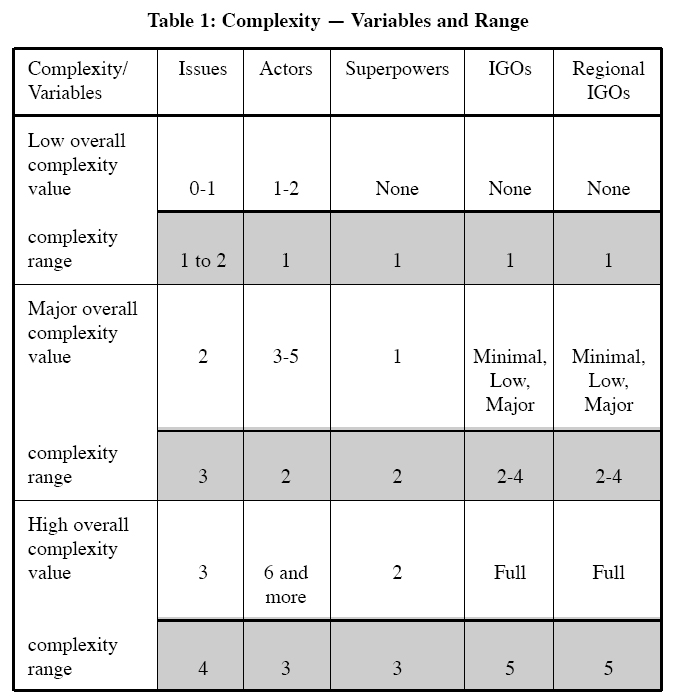
Display large image of Table 1
21 For issue complexity we build upon previously coded variables. For territory we use type of rivalry which is based on ICB coding for territoriality. Its values are: 1. territory-dominant; 2. territory-driven; 3. territory related; and 4. non-territorial rivalry. Values 1 to 3 involve a territorial issue while value 4 indicates a non-territorial struggle. Second, for stakes, the shorter term and more specific core topics in the confrontation, the gravity variable in the ICB dataset at the system level was used. Unlike gravity of value at the actor level that focuses on the perceptions, at the system level this variable identifies the core topic in the struggle. System level gravity includes seven stakes: existence, grave damage, territory, influence, political regime, economic, and limited military damage. A category of ‘other’ is also listed to accommodate unique stakes, all of which are non-territorial in nature.25 For the issue of ethnicity we use crisis type which identifies wars that occur in interstate-ethnic crises by using ethnic issue which denotes five ethnic specific issues: cross-border turmoil, ethnic kinship/minority ties, terror, de-colonization struggle, and civil war. The most salient among these issues is coded as the primary issue in the confrontation.26 In an ethnic-state crisis, state adversaries along with ethnic actors participate in the confrontation. An ethnic issue is coded in a crisis only when a non-state actor takes part in the struggle alongside states, thereby adding to the complexity of the confrontation. From this outlook, ethnicity does not mean ethnic diversity but rather the involvement of an ethnic actor, the issues it sets on the agenda, and the turmoil that follows its activities. For the issue of COC we use type of civilization confrontation that distinguishes between inter-civilization and intra-civilization confrontations.27 The adversaries are classified into either the same civilization or different ones. The definition of a civilization follows the original formulation proposed by Huntington.28 The actual coding of particular adversary states to the different civilizations is based on previous studies that tested the COC thesis.29 Civilizations are a much broader concept than ethnicity and a COC issue can be found in a struggle between state adversaries alone, while an ethnic non-state actor must be involved when an ethnic issue is coded. An additional category, other issues, covers cases that do not belong to the three issues mentioned above. These cases are designated as low issue complexity (0 complexity score). In future research these “other” issues should be investigated and added to the list of issues that contribute to complexity.30 Some of these issues, such as regime and policy, already appear in COW and are addressed by Vasquez and Valeriano.31
22 Structure refers to the actors and the distribution of power between them (polarity). When we designate structure complexity, we focus on the number and type of actors involved and in their power rank. Unlike the dyadic nature of many war studies, ICB recognizes that wars involve multiple actors: states of diverse power rank and international organizations. To describe structure complexity we build upon ICB variables that focus on the participants in the confrontation: crisis actors (CRACTR); superpowers (hereby SPs), which include the US and USSR/Russia (USACTOR and SUACTOR); international organizations (hereafter IGOs), which focuses on United Nations activity (GLOBORG and GLOBEFAC); and regional IGOs (REGORG and ROEFAC). When information is missing in ICB data on these variables we supplement them with information from ICB variables: GLOBORG, GLOBACTM, REGBODY, and REGACTMB.
23 For the number of state adversaries we identify three values: 1. low (one to two actors); 2. major (three to five actors); and 3. full (six and more actors).
24 To account for power rank we look at superpower complexity in crisis. We identify three values: 1. none (no SP active as crisis actor); 2. low (one SP); and 3. full (both SPs). To account for type of actors involved we define four levels of structural complexity integrating the identity of the organization involved and the nature of its involvement in the wars crisis: 1. none; 2. minimal; 3. low; 4. major; and 5. full structural complexity.
Overall Complexity
25 The index of overall complexity, outlined in Table 1, integrates issue and structure complexity. The overall complexity score for each war is derived by adding the complexity score for each of the components leading to a theoretical overall range from a score of 2 to 20, with none to one issue and one to two actors, to maximal — with the presence of all three issues, six or more adversaries, two superpowers, and full IGO and regional organization involvement. Our findings reveal that in reality, the overall scores for the 55 wars in this study range from 7 to 18.32 The analysis of overall complexity is based on three levels within this range: 1. low (overall scores of 5-9); 2. mid-level (overall scores of 10-15); and 3. high (overall scores of 16 or more). These empirically derived thresholds are useful in presenting an index of war complexity. Future analysis of this variable as continuous can lead to explanatory results that are beyond our present goals.
Expectations: Postulates and Assumptions
26 We follow the basic premise that Richardson highlighted and Vasquez and Valeriano probed: simple and complex wars differ. Their outcome will therefore also vary. Translating this starting point into postulates on war complexity and outcome, we anticipate that:P1. Wars over a territory issue are more likely to end in an accommodative outcome than wars involving all other issues.P2. Wars over a COC issue are more likely to end in a non-accommodative outcome than wars involving all other issues.P3. An ethnic issue will rarely escalate to full-scale war, but when it does, the war will most likely end in a non-accommodative outcome.P4: War crises with higher complexity — in terms of issue, structure, and overall complexity — are more likely to end with non-accommodative outcomes than cases with lower complexity.These postulates are based on assumptions related to two core aspects that affect outcomes: the importance of reaching a compromise and the difficulty in concluding an agreement at the end of a war.33 These two aspects operate in conjunction with the type of issue involved and the complexity of the case, thereby leading to our assessments regarding the extent of accommodation in postulates 1-4.
27 The issue-specific postulates (P1-P3) relate to the three approaches from which they are derived. In the case of territorial wars simple (dyadic) wars tend to involve core yet tangible stakes. The conflict over territory as a core interest often leads to war but unlike religion and fundamental beliefs territory can be divided. Hence, it is therefore reasonable to expect some accommodation at the end of a territorial struggle, even if only as a result of power politics that shape the extent of compromise. Territorial wars may involve an extended alliance structure and many adversaries but often involve two neighbor states. By contrast, COC wars are stipulated to be the harshest confrontations involving the most fundamental and non-tangible stakes and complex structures. As Huntington presents it, civilizations are a totality, the “biggest ‘we’ within which we feel culturally at home as distinguished from all the other ‘thems’ out there.”34 All these elements, together, create the strong and rigid civilization alliances, adversarial blocs, and coalitions that fight one another. Compromise in these wars is unlikely due to the zero-sum game between rival civilizations, their competing values, and clashing norms. The structural difficulty of concluding a multi-state war in an agreement that will satisfy all parties adds to the lower chances of concluding such a confrontation in any type of agreement.
28 The case of ethnicity, as an issue in war, is more complex because ethnicity is most often related to civil wars and low-intensity conflicts. Consequently, our third postulate claims that ethnic confrontations that escalate to full-scale war are relatively rare and have a logic that is separate from other wars. When interstate and sub-state elements are intertwined, ethnic actors are involved alongside state adversaries and low-intensity conflict/civil war usually precedes the escalation to full-scale interstate war. Compromise in such cases is rare because the lingering nature of low-intensity violence subjects ceasefire agreements and proposed settlements to a test of endurance. Central government control and outside support, two vital elements for consolidating an accord in such cases, are often lacking. Moreover, when ethnic actors place their demands at the negotiation table, it is hard to satisfy the core adversaries who often de-legitimize one another. The end result is that wars over ethnic issues are concluded with a non-accommodative outcome.35
29 With respect to overall complexity, involving not only issues but structure too, we assert that in low complexity wars it is relatively easy, and also important, to reach a compromise. When the interests at stake lead to war but only a few actors of similar rank and type are involved, compromise can be outlined, negotiated, and monitored. In high complexity wars involving many actors with diversity in power and type, though compromise is essential in order to re-establish order and stability, it is quite difficult to reach and maintain. Even the super-powers and IGOs/regional IGOs, who participate as mediators in such cases, often fail to resolve the confrontation. Hence we anticipate that the higher the complexity of war, the less likely is an accommodative outcome.
30 Our postulates relate to regular war crises in which the crisis begins before the war erupts.36 We also add IWCs, where a long ongoing war is waged before the crisis begins, as a control group. Such situations involve major escalations and defeats that take place during an ongoing war that indicate a transition in the conflict setting and the onset of a war crisis.37 During IWCs the role of violence and animosity is paramount, not only throughout the crisis but also before it starts and at times even after it ends. As such, these cases are a distinct subset of wars that might be said to epitomize the logic of war or, by contrast, embody the cycle of primordial hostility and enduring confrontation. We explore both groups of wars to check the correspondence between issue/structure complexity and outcomes. We expect to find diversity in war patterns and anticipate that the logic of our postulates will be relevant to regular war crises while other trends will be found in IWCs, reflecting the overwhelming role of violence and animosity that exist before the crisis even starts.38
Findings
31 The study of 55 war crises over the period from 1946 to 2002, derived from the ICB dataset, is designed to explore whether or not variations in war complexity are coupled with differences in accommodation at the end of the confrontation (see Appendix 1). We first probe issues in terms of substance and complexity; second, we investigate structure complexity; and third, we conclude with an analysis of overall complexity and outcomes in war crises.
Issue Complexity and War
32 Do regular wars and IWCs differ in terms of the issues they involve? Are distinct issues coupled with accommodation or non-accommodation? We address these queries by analyzing the substance and complexity of the issues.
33 Findings on issues and outcomes in regular wars and IWCs, our control group, are presented in Table 2. Among the 55 war crises we probe, 69 percent of the wars (38 cases) are regular wars and 31 percent of them (17 cases) are IWCs. What characterizes wars in terms of their core issue? How are issues clustered to create issue complexity in wars? Does high-issue complexity couple with non-accommodative outcomes?
34 When only one issue is present in a war crisis, issue complexity is low and different levels of accommodation are coupled with various issues depending on the substance, supporting postulates 1 to 3 regarding regular wars and only partly so with respect to IWCs.
35 In regular wars most crises involving territoriality tend to end in accommodation (75 percent), supporting postulate 1; all the cases with a COC issue end in non-accommodation, supporting postulate 2; and, since most international wars between 1946 and 2002 do not involve ethnicity at all, evidently ethnicity is not a central issue when interstate wars are concerned.39 How do the few wars that involve ethnic issues end? Some ethnic wars are coupled with accommodation but findings indicate that ethnicity does not appear alone as a single issue.40 Rather it is often coupled with one or two more issues that in conjunction with ethnicity are resolved mostly in a non-accommodative mode, thereby supporting postulate 3. When ethnicity is coupled with a COC issue, most cases end in a non-accommodative outcome (62.5 percent) and when territoriality and ethnicity are evident non-accommodation follows.41 More specifically, when two issues are involved, in regular wars most cases end in non-accommodation but when either territoriality or ethnicity are coupled with a COC issue some accommodation exists, unlike the total non-accommodation which is found when only a COC issue is present. Hence, in the territoriality-COC group, 33 percent of the crises end in accommodation while 67 percent do not, and in the COC-ethnicity group 37.5 percent of the cases end in accommodation while 62.5 percent do not. A COC is therefore not a good sign when accommodation in war is a desirable ending. When all three issues are present the trend reverses itself in favor of an accommodative outcome in 71 percent of all regular wars, while only 29 percent of the cases end in non-accommodation. Accommodation is therefore most likely when territoriality is at stake or when all three issues are involved, that is, when issue complexity is high.
Table 2: Issue Substance and Outcomes
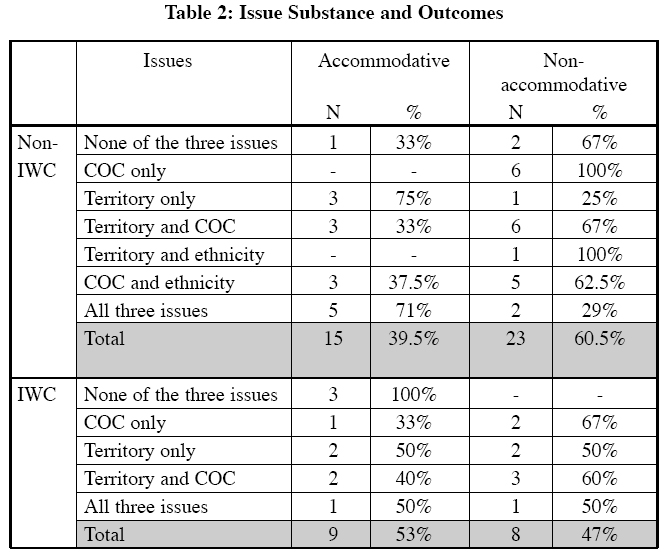
Display large image of Table 2
36 Turning to our control group of IWCs, long wars where violence is protracted in nature and precedes the outbreak of the crisis, mixed trends are found and the extent of accommodation is low in all issues except for the group of “other” issues.42 Most of the wars with a COC issue end in non-accommodation (67 percent) and even in long wars with a territorial issue or containing all three issues the chances of accommodation/non-accommodation are even (50:50), though these cases involve a slightly better prospect in terms of compromise and conflict resolution than cases with a COC issue alone.
37 When we compare regular wars and IWCs we find that quite the same trends exist with respect to COC alone and to territory coupled with COC. In the case of a COC issue all regular wars end with non-accommodation and most IWCs do so (67 percent). When both territory and a COC issue are evident, 67 percent of the regular wars end with non-accommodation and 60 percent of the IWCs do so. In crises with none of these three issues and with all three issues together, the trends are quite different in regular wars and IWCs. First, in the group where none of the three issues are involved, 67 percent of the regular wars end in non-accommodation, while all cases in the IWC control group end in accommodation. When all three issues are involved and issue complexity is high, 71 percent of the regular wars but only 50 percent in the IWC group end in accommodation. What do these findings indicate in terms of low- and high-issue complexity and war outcomes?
38 Findings on issue complexity are presented in Table 3 in terms of a scale ranging from none, via minimal and major, to full-issue complexity. These findings lead us to reject our theoretical expectation spelled out in postulate 4 on issue complexity regarding regular wars and to accept it partly regarding the control group of IWCs. When full-issue complexity is evident the prospects of accommodation are high in regular wars and drops considerably in IWCs.
Table 3: Issue Complexity and Outcomes
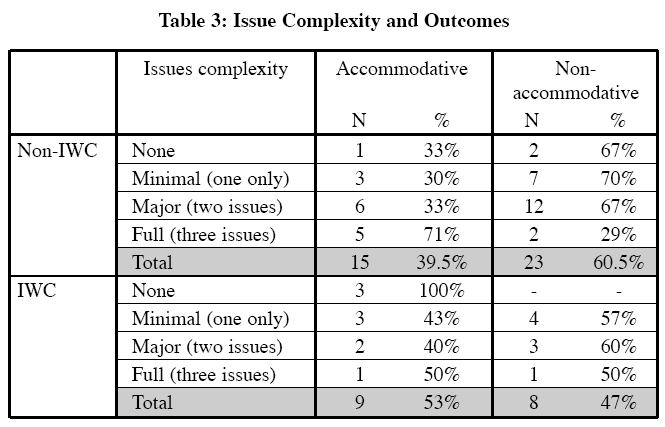
Display large image of Table 3
39 In regular wars accommodative outcomes are more likely than non-accommodative ones (71 percent) only in full-issue complexity. In the lower levels of issue complexity involving none, minimal, and major complexity, most of the crises end in a non-accommodative ending. Only some 30 percent of the cases are accommodative in nature.
40 When we turn to long wars in the IWCs control group this trend disappears. A rather close level of non-accommodation appears in all three complexity levels, with 57 percent for minimal complexity, 60 percent for major, and a drop to 50 percent non-accommodation for full-issue complexity. By contrast, as noted earlier, all cases where the issues we analyze are not evident at all are resolved in accommodation.
Structure Complexity and War
41 The type and power of adversaries also indicate war complexity. Hence, we probe actors, superpower involvement, and the participation of IGOs/regional IGOs as indicators of structure complexity. First we address each element of structure complexity on its own and compare regular wars with our control group of IWCs. Then we explore the correspondence between overall complexity and outcomes, anticipating that higher complexity will be coupled with less accommodation in war crises.
Crisis Actors and Outcomes
42 Do regular wars differ from IWCs in the extent of actor complexity? Does high actor complexity correspond with non-accommodative outcomes as anticipated in postulate 4? The findings presented in Table 4 show that indeed regular wars and IWCs differ and that postulate 4 is supported in the former but not in the latter.
Table 4: Structure Complexity — Actors and Outcomes
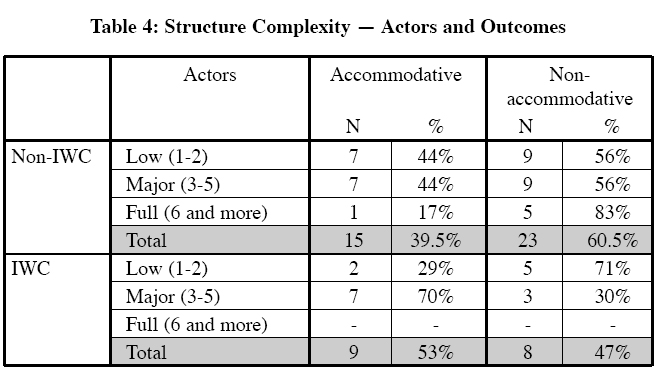
Display large image of Table 4
43 In regular wars both in the low and major actor complexity levels, 56 percent of the cases are non-accommodative, and in the full actor complexity, with 6 and more actors involved, non-accommodation rises to 83 percent. By contrast, in IWCs, where all cases are either of low or major actor complexity, 29 percent of the former end in accommodation and 70 percent of the latter. Contrary to the anticipation in postulate 4, the rise in accommodation follows the rise in actor complexity. Hence, while in regular wars high actor complexity follows the logic of postulate 4 that links high complexity with non-accommodation, in IWCs with many participants the logic changes and compromise takes place.
Superpowers and Outcomes
44 Do regular wars differ from IWCs in the extent of superpower complexity? Does high superpower complexity correspond with non-accommodative outcomes as anticipated in postulate 4?
45 The findings presented in Table 5 support postulate 4 regarding regular wars but not for IWCs. In regular wars we find that 52 percent of the crises with no superpower involvement end in non-accommodation. Non-accommodation rises to 83 percent of the cases with one superpower involved and to 80 percent of the cases with both superpowers involved. Clearly, in these cases, as anticipated in postulate 4, accommodation and high superpower complexity are not coupled.
46 In the control group of IWCs a mixed trend appears: accommodation drops from 54.5 percent to 40 percent with the rise from no superpower complexity to one superpower only, supporting postulate 4. But accommodation rises sharply to 100 percent when both superpowers are involved, contrary to the expectations spelled out in postulate 4. Once more, as in actor complexity, it seems that perhaps the dangers of escalation or fatigue introduce some prudence and high complexity is coupled with compromise at the end of the confrontation.
Table 5: Structure Complexity — Superpowers and Outcomes
IGOs and Outcomes
47 Do regular wars differ from IWCs in the extent of IGO complexity? Does high IGO complexity correspond with non-accommodative outcomes as anticipated in postulate 4?
48 The findings presented in Table 6 support postulate 4 for regular wars but not for IWCs. In regular wars, the rise of IGO complexity is coupled with a corresponding rise in non-accommodative outcomes as stipulated in postulate 4: 50 percent of the cases end in non-accommodation when no IGO activity exists; 60 percent, when low IGO complexity is found; 65 percent when major IGO complexity exists; and 62.5 percent when full IGO complexity is present in wars. Support for postulate 4 on this aspect of complexity points to the fact that conventional wisdom regarding IGO activity is not automatic. Though IGOs are regarded as mediators that attempt to promote conflict resolution, their role in enhancing war complexity is often coupled with the opposite result: a nonaccommodative ending of wars.
49 In IWCs the trend reverses itself and with the rise in IGO complexity a corresponding rise in accommodation is found, thereby rejecting postulate 4 and supporting conventional wisdom regarding IGO contribution to crisis management and conflict abatement, despite their role of increasing structural complexity. While 50 percent of the IWCs with no IGOs involved end in accommodation, 43 percent of them end so when low IGO complexity exists, 60 percent when major IGO activity is found, and 67 percent when full IGO complexity is present.
Table 6: Structure Complexity — IGOs and Outcomes
Regional IGOs and Outcomes
50 Do regular wars differ from IWCs in the extent of regional IGO complexity? Does high regional IGO complexity correspond with non-accommodative outcomes as anticipated in postulate 4?
51 The findings presented in Table 7 do not support postulate 4 in either regular wars or IWCs. For once, non-IWCs and IWCs follow a similar logic and in both types of war a rise in regional IGO complexity is coupled with a rise in accommodation. This trend could lead to a refinement in the conventional wisdom regarding IGO roles in war crises: while both IGOs and regional IGOs add to complexity, accommodation decreases when IGOs are involved but increases when regional IGOs do so. This is true in regular wars and in IWCs. In more detail, when examining regular wars: 78 percent of the cases end in non-accommodation with no regional IGO complexity, 60 percent when low regional IGO complexity is found, 54 percent when major regional IGO complexity exists, and when full regional IGO complexity is present in wars all cases are accommodative. Quite similarly, in the control group of IWCs: 40 percent of the cases end in non-accommodation with no regional IGO complexity, 67 percent when low regional IGO complexity is found, and when major regional IGO complexity exists all the cases end in an accommodative manner. No cases of full regional IGO complexity are present in IWC wars. Notably, though low regional IGO complexity seems to hamper accommodation, with the decline in such outcomes from 60 percent to 33 percent when a shift is made from no involvement to low regional complexity, but in the major regional complexity all cases, are accommodative, pointing to the fact that though regional IGOs add to complexity, like IGOs, their activity is coupled with accommodation more than that of IGOs.
Table 7: Structure Complexity — Regional IGOs and Outcomes
Overall Complexity and Outcomes
52 Does the overall complexity of regular wars differ from that of IWCs? Does high complexity correspond with non-accommodative outcomes, as anticipated in postulate 4? How do different types of war score on the complexity index? Table 8 presents a summary of complexity levels and outcomes for the 55 wars we probe herein. Based upon the issue and structure indicators of complexity we calculated a complexity score for each case. The analysis of complexity is based on three levels within this range: 1. low (overall complexity lower than 9); 2. mid-level (overall complexity of 10-15); and 3. high (overall complexity of 16 or more).
53 What do we learn from these scores about war complexity and outcome? The results do not support postulate 4 for both regular wars and IWCs, though the patterns in both groups vary. Our findings point to the conclusion that overall complexity tends to be coupled with accommodation but some patterns vary. In the group of regular wars, 50 percent of the wars characterized by low complexity end with non-accommodation, 64 percent in the mid-complexity range, and 60 percent in the high complexity level. Most accommodation is found therefore in the low-level complexity category indicating support for postulate 4, based on the decline from 50 percent to 36 percent accommodation which corresponds with the shift from low to mid-level complexity, and a rather close 40 percent at the high complexity.
Table 8: Overall Complexity Range and Outcomes
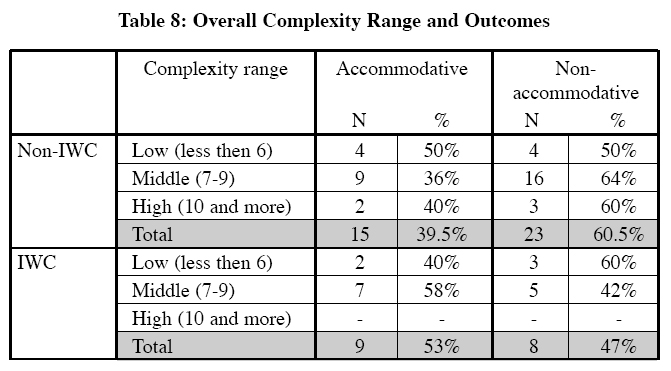
Display large image of Table 8
54 In the IWC group, some mixed trends are evident but the main pattern points to a rejection of postulate 4 because non-accommodation in these cases drops from 60 percent to 42 percent when a shift is made from low to mid-level complexity. Accordingly, a rise in accommodation is found from 40 percent in the low level complexity to 58 percent of the cases in mid-level complexity, highlighting the trend that increased complexity is accompanied with more accommodation.
CONCLUSION
55 Not all wars are the same. This is clear from our findings on war crises, complexity, and outcomes. Using our variables for classifying issues, structure, war complexity and outcomes, wars are not coded alike but patterns of complexity and outcome do exist within subsets of wars. For example, in a rising order of overall complexity score (CS): the Black September confrontation of 1970 is coded as a CS of 12 and a non-accommodative outcome; the 1982 War in Lebanon involves a CS of 13 and an accommodative outcome; in the 1973 October War in the Middle East the CS is 15 with an accommodative outcome, while the 2001 War in Afghanistan also has a CS of 15 and a non-accommodative outcome; the Suez War of 1956 has a CS of 16 and a non-accommodative outcome; the 1991 Gulf war scores 18 on the CS with a non-accommodative outcome.43 What does this mean? Our findings converge with those of earlier studies on war diversity and therefore they increase the generality of a core stipulation in our field: wars vary greatly. This stipulation is now supported by evidence on wars from 1918 (COW/MID) to 2002 (ICB) and multiple datasets (COW, MID, ICB). In the future the emergence of a comprehensive theory of war and peace in world politics should take the stipulation that ‘not all wars are alike’ as its starting point. But more research on this topic is clearly needed, taking a closer look at ethnicity, civil wars, political regime, culture, and other topics that have been relatively neglected compared to the cumulative research efforts devoted to state-centric aspects.
56 More specifically, what do our findings mean? Do wars vary with complexity and is complexity associated with outcomes? When we combine our results we learn that territory, COC, and ethnicity are meaningful issues in war and that wars over these issues vary in their outcomes, mainly supporting postulates 1-3 in regular wars and providing less support in the IWC control group. Here it seems that primordial animosity, violence, and fatigue may override the effects of issue substance. Examples occurred in Indonesia’s struggle for independence, during the ongoing war in Yemen, throughout the Indochina confrontation, and during the prolonged Iran-Iraq War. Regarding postulate 4, on the coupling of complexity and non-accommodative outcomes we found that some issue and structure elements in non-IWCs support postulate 4 (actors, superpowers, and IGOs), while others do not (issues, regional IGOs, and overall complexity). In the IWC category our control group, in which full-scale war precedes the onset of the crisis, postulate 4 is rejected by all elements with the exception of issue complexity that indicates some support. In summary, with the rise in complexity, regular wars are less accommodative and IWCs are more accommodative. This finding introduces a somewhat more optimistic tone to the analysis of wars: the possibility of escalation management and the prospects of conflict resolution in crises that occur during ongoing long wars.
57 In our analysis we also found that the substance of issues as well as their complexity is coupled with war outcomes. As outlined in postulates 1-3, the most accommodative of all issues is territory (for examples, the 1973 October War) and the least accommodative is COC (for example, the 2001 Afghanistan War). The prospects of compromise in a war with a COC issue increases somewhat if it is coupled with ethnicity or territoriality or both (for example, the 1947-48 Palestine partition/Israeli independence crisis). These trends, though much less pronounced, are also evident in IWCs. Overall, these results, supporting the substantive aspect of issues and postulates 1-3, though not fully, demonstrate the usefulness of using issues to indicate complexity.
58 What do we learn about structure elements of complexity and war outcomes? Structure is indicated by diversity in the number and type of participants in war crises. In terms of diversity in scope of actors, while in regular wars high actor complexity follows the logic of postulate 4 that links escalation and non-accommodation (for example, 1991 Gulf War), in IWCs with many participants the logic changes and prudence/compromise takes place.
59 When we turn to power structure and superpower involvement in regular wars, as anticipated in postulate 4, accommodation and high superpower complexity are not coupled. But in the control group of IWCs a mixed trend appears and once more, as in actor complexity, it seems that the dangers of escalation introduce some prudence, if not fatigue, so that high complexity is coupled with compromise at the end of the confrontation.
60 Structural elements of complexity also involve diversity in type of crisis participants. Regarding the involvement of IGOs, though these organizations are regarded as mediators that attempt to promote conflict resolution, our findings show that their role in enhancing war complexity is often coupled with the opposite result: a non-accommodative ending of wars. However, this is not the case with respect to regional IGOs. For once, regular wars and IWCs follow a similar logic and in both types of war a rise in regional IGO complexity is coupled with a rise in accommodation. This trend should lead to a refinement in the conventional wisdom regarding IGO roles in war crises: while both IGOs and regional IGOs add to complexity, accommodation decreases when IGOs are involved but increases when regional IGOs do so.
61 Do these mixed findings regarding regular wars, the majority of cases in our study, mean that overall complexity really matters? Both the operational complexity index and the concept of complexity are core attributes of wars that describe their unique characterization. Outcomes, however, are the last step in the war process and its de-escalation dynamics. Consequently, it is not surprising to find that outcomes do not fully correspond with complexity alone. In fact, the diversity in wars and their outcomes is a reasonable and important finding. War complexity should be probed further to assess its salience in explaining fundamental war phases, from initiation, via coping and management, to termination.
62 By choosing to focus on war crises, the most hostile confrontations in world politics, we have no a priori reason to expect that wars will end in compromise or that war crises will terminate in accommodation. In the event that some accommodation patterns are found we should try to understand their unique nature, analyze the processes they involve, and investigate how they differ from other types of wars that end without compromise. This will hopefully enable us to manage crises in a better way and prevent future uncontrolled escalation of violence to war.
63 Finally, one may ask: why study war in the current period of terror, civil-ethnic driven struggles, and low-intensity conflicts? Perhaps all our efforts should be geared to alternative research agendas that might offer new insights on what seem to be the most threatening aspects of our existence?44 One of the major contributions of a multi-path ‘steps to war’ model might be in helping us grasp the big picture, even when we are confronted with the specifics of current developments. The expansion of new research fields must not come at the expense of a re-examination of classical topics — conflicts, crises, and wars. The study of war in the post 9/11 era should therefore be multi-focal, as Steve Smith claims.45 We, too, believe that a multi-focal approach is important for the study of wars in the twenty-first century. ICB, COW, MID, and other databases, as well as major theories in our field, are indeed state-centric in orientation. And yet, we have to be careful not to discard all state-centric material just because it does not always relate to the ‘other’ aspects that make up the present world. The analysis of patterns, regularities, and transformations in the past, present, and future arenas of world politics should take into account the fact that not all wars are alike. Distinct issues matter and accommodation patterns are associated with the specific issues at stake. As a result, the ‘steps to war’ cannot always be identical and a multi-faceted model should be created to explain war and peace over time and space.
64 Hemda Ben-Yehuda is Senior Lecturer in the Department of Political Science at Bar Ilan University.
Appendix 1 — Master Table of War Crises
Appendix 1 — Master Table of War Crises
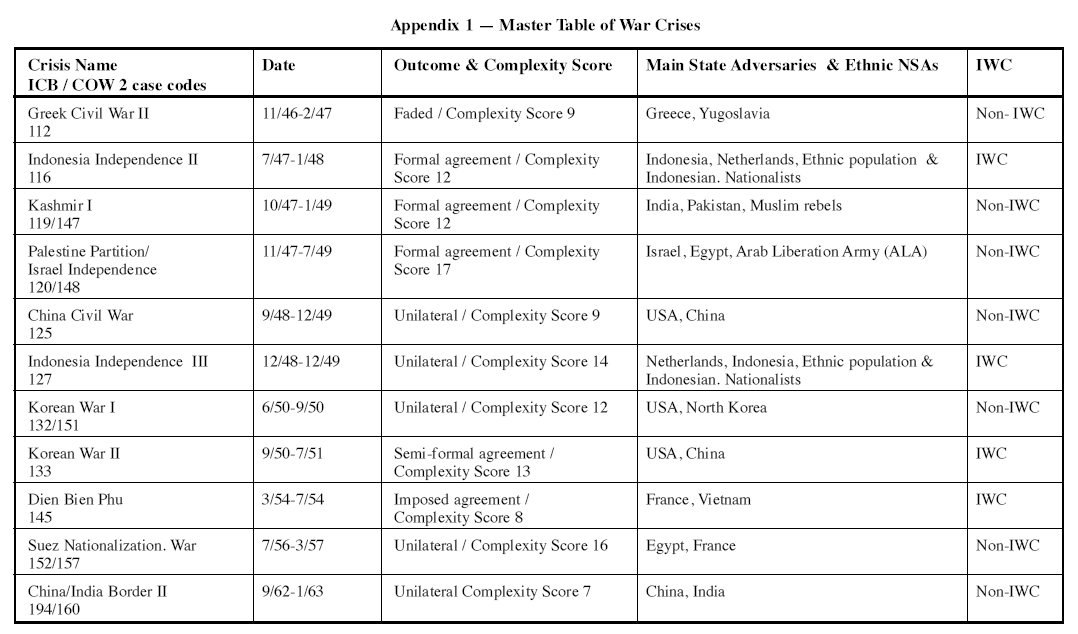
Display large image of Table 9
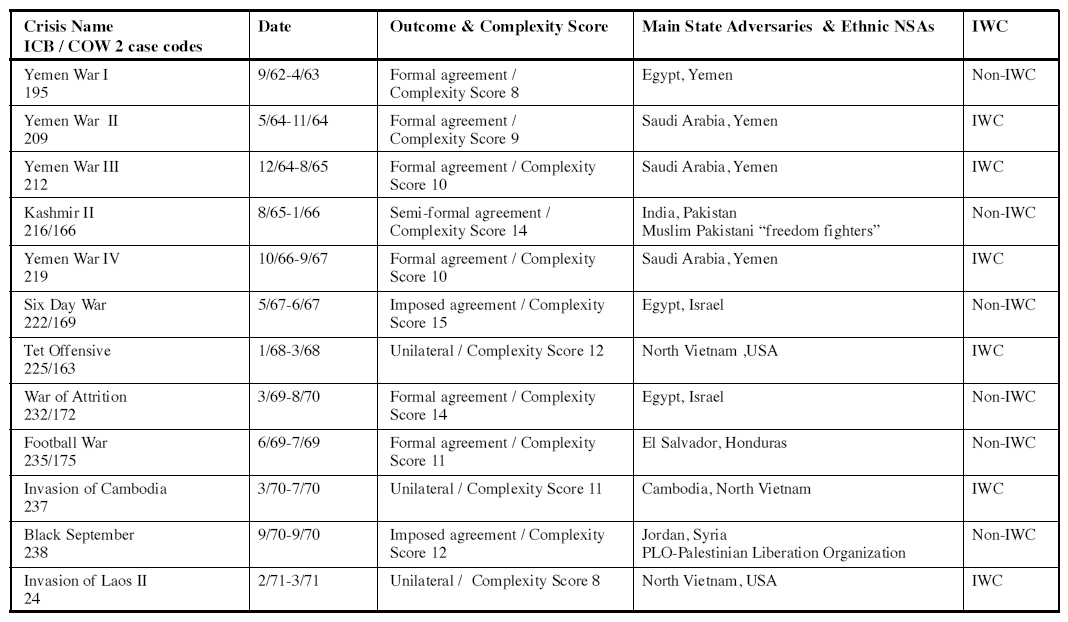
Display large image of Table 10
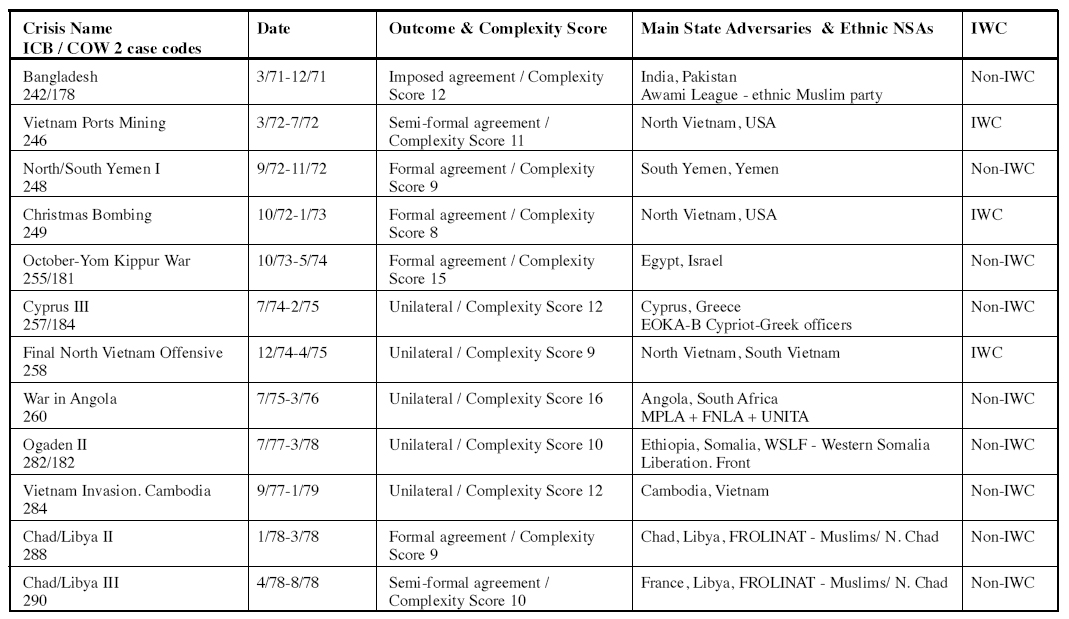
Display large image of Table 11
Endnotes
